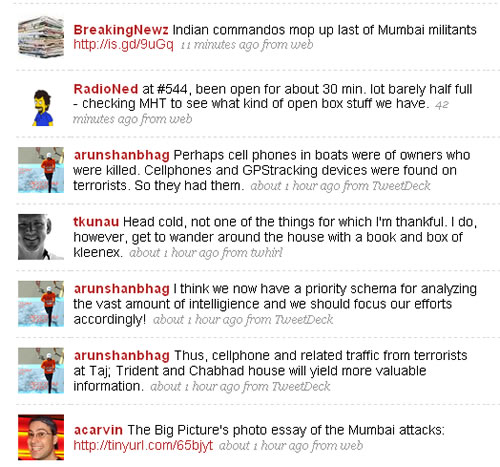The situation in Mumbai is now over and we will soon forget about it and return our attention to the U.S. Senate recount in Minnesota and the special on doodads at the local Buy More. But for fans of journalism and social networking, not before we take stock of what we’ve learned about the changing communication landscape.
As documented here and several thousand other places since Wednesday, Mumbai was a turning point in media — and in particular, Twitter — the same way the 60 Minutes story on George Bush’s military service was the turning point for blogs. We’re not going back.
The tendency is to view this in the context of us vs. them; that is, does Twitter now make mainstream media even more irrelevant? No. Some media choose to be irrelevant all by themselves (The Star Tribune op-ed pages, for example, have yet to carry the word Mumbai and there’s been three editions since the terror began. At the same time, it found room today for a warning that the Internet is now in the hands of Democrats, as if somebody actually owns the Internet) .

Much of the material that people consumed from Mumbai via Twitter was based on NDTV or CNN-IBN reports, and then repeated on Twitter. But there was actual reporting being done — better — via social networking by people such as Vinukumar Ranganathan, a business development manager who is the person known as vinu on Flickr and Twitter. At the height of the conflict on Thanksgiving, he was the only source for eyewitness information because it was happening next door to where he lives. Blogs, such as Arun Shanbhag‘s, filled in the blanks admirably and expertly.
“Twitter isn’t the place for solid facts yet – the situation is way too disorganized. But it’s where the news is breaking,” Michael Arrington wrote on Tech Crunch. But he was wrong; it was the source for solid facts.
On her blog, Teaching Online Journalism, Mindy McAdams writes of 10 things she’s learned from the Mumbai coverage. ” Breaking news — especially disasters and attacks in the middle of a city — will be covered first by non-journalists,” she said. “The non-journalists will continue providing new information even after the trained journalists arrive on the scene.”
Closer to the point, what we saw here was not the suspected replacement of one medium with another, but the merging of the two (or three). The news organizations which best understood that have figured out how to create content in the social networking space rather than using social networking only to repackage it into traditional TV, or radio, or even Web sites. The best social networkers have figured out how to merge mainstream media into their space. Those who found themselves out of the game, were the ones who didn’t. Their time is running out.
To be sure, the signal-to-noise ratio on platforms like Twitter can be unbearable for any intelligent adult. In its technical infancy, it doesn’t yet provide an easy way to filter irrelevant material and, as with most new media, small groups of early adopters/social networking experts are slowing its evolution by trying to dictate the “right” way to use it. It is, afterall, social networking and one has to define one’s own social comfort zone. And it’s true that there’s danger in overestimating the value of social networking during breaking news; it’s still a good method of repeating bad information.
On the other hand, if you can turn off the noise, the opportunities for being better informed are endless. The access to information from around the world has never been better, a follower on Twitter said to me yesterday. She was somewhat frustrated that Americans aren’t taking advantage of it. The last three days have suggested the situation is changing and the world isn’t going to revolve around those who are willing to be left behind.
“I have always been a shutterbug. Would love to be a photo journalist someday!” Vinu Ranganathan told Wired.com.
He already is. And so are you.
